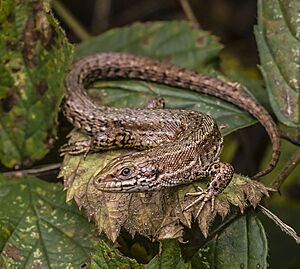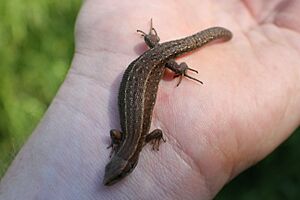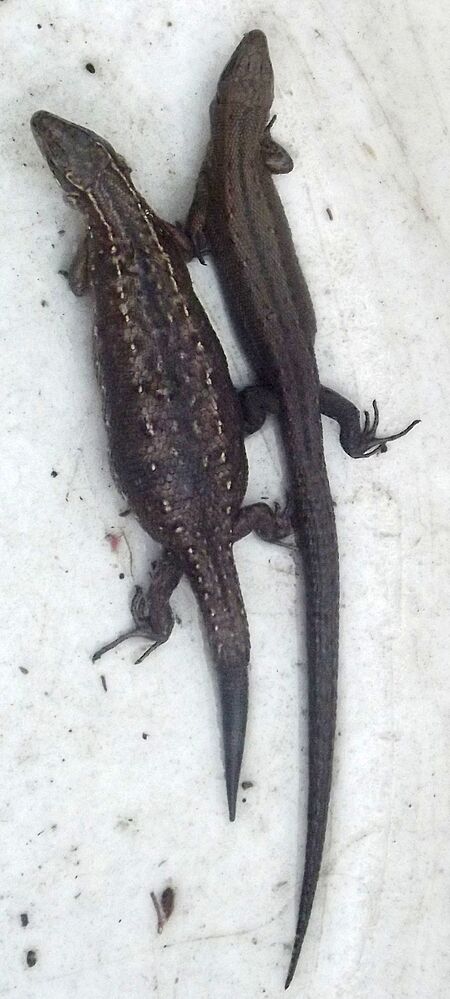Viviparous lizard facts for kids
Quick facts for kids Viviparous lizard |
|
|---|---|
 |
|
| Conservation status | |
| Scientific classification | |
| Genus: |
Zootoca
|
| Species: |
vivipara
|
 |
|
| The viviparous lizard is found across Northern Europe through Central Asia, ranging further north than any other land-dwelling reptile. | |
| Synonyms | |
|
Lacerta vivipara Lichtenstein, 1823 |
|
The viviparous lizard, also known as the common lizard, is a fascinating reptile found across Europe and Asia. Its scientific name is Zootoca vivipara. This lizard is special because it lives further north than any other reptile that lives on land.
Its name, "viviparous," means "giving birth to live young." Most reptiles lay eggs, but this lizard often gives birth to baby lizards that are already hatched. Both parts of its scientific name, Zootoca and vivipara, mean "live birth" in different old languages.
These lizards are unique because they only eat meat, like flies, spiders, and other insects. They can also survive in very cold places. They even freeze solid in winter and then thaw out when it gets warmer!
Contents
About the Viviparous Lizard
The viviparous lizard is a small reptile, usually about 15 to 20 centimeters long. They can be many different colors, like brown, red, grey, green, or black.
Male and female lizards look a bit different. This is called sexual dimorphism. Female lizards often have different colors on their bellies, from pale yellow to bright orange. Scientists think these colors help them with social signals, especially when it comes to having babies.
Male lizards usually have brighter, more colorful undersides, with yellow, orange, green, or blue. They also often have spots on their backs. Females, on the other hand, usually have darker stripes along their backs and sides. Males also tend to have bigger heads than females. A larger head helps male lizards be more successful when they compete for mates.
Where Viviparous Lizards Live
Their Home Environment
Zootoca vivipara lizards spend most of their time on the ground. They love to warm up by basking in the sun. When the weather gets very cold, they go into a deep sleep called hibernation to stay warm. They usually hibernate from October to March.
You can find them in places like heathland (open land with small shrubs), moorland (grassy, open hills), woodland (forests), and grassland (open fields).
Where They Are Found
The viviparous lizard lives across a huge part of northern Europe and Asia. In Europe, they are found north of the Alps and Carpathian mountains, including the British Isles. They also live in parts of Spain and the Balkans. In Asia, they are common in Russia, Kazakhstan, Mongolia, China, and Japan. This lizard has the largest natural range of any lizard species in the world!
Viviparous Lizard Habits
What They Eat
Unlike many other lizards, Zootoca vivipara are strict meat-eaters. Their diet includes flies, spiders, and many other insects. They are active hunters and will chase down their prey. Studies show that female lizards often eat more food than males, especially when there is more sunshine.
Who Hunts Them
Many animals hunt viviparous lizards. Common predators include birds of prey, crows, snakes, shrikes, hedgehogs, shrews, foxes, and even domestic cats. Sometimes, larger males are hunted more often by birds like the great grey shrike. This might be because males are more active during the breeding season.
Health and Parasites
These lizards can sometimes get tiny parasitic worms called helminths. The type of parasites they have can depend on what they eat. Lizards that eat more insects tend to have fewer different types of parasites. Also, larger lizards often have more parasites.
They can also have tiny blood parasites. Studies have shown that about 39.8% of viviparous lizards might have these blood parasites. Interestingly, male and female lizards are equally likely to get them.
Reproduction and Life Cycle
Live Birth vs. Egg Laying
The viviparous lizard is famous for giving birth to live young. However, some groups of these lizards can also lay eggs! Scientists used to think that giving live birth evolved only once from egg-laying. But newer research suggests that live birth might have evolved multiple times in different groups of these lizards. It also seems that going back to egg-laying might not be as rare as once thought.
Lizards that give live birth are found from France all the way to Russia. Lizards that lay eggs are mostly found in northern Spain and southwest France. When lizards from live-birthing groups and egg-laying groups try to have babies together in a lab, the baby lizards often have problems.
Number of Babies
For lizards that lay eggs, how many clutches (groups of eggs) they lay and when they start reproducing can depend on how high up they live. Lizards living at higher altitudes usually start reproducing later and lay fewer clutches, often just one, each year.
How Long They Live
Viviparous lizards typically live for about 5 to 6 years.
Mating Behavior
Male viviparous lizards have larger heads than females. On average, male heads are about 5.6 mm wide and 10.5 mm long, while female heads are about 5.3 mm wide and 9.7 mm long.
Male Competition
A male's head size is important for winning fights with other males. They use their heads like weapons. Males with larger heads are usually more successful in these fights. These fights are often about getting access to females for mating. So, males with smaller heads might have fewer chances to reproduce.
Staying Warm in Cold Places
This lizard lives in incredibly cold places, even subarctic regions. To survive, they need to control their body temperature, a process called thermoregulation. Even though it costs a lot of energy to stay warm in such extreme cold, these lizards still actively warm themselves, for example, by basking in the sun.
Thermoregulation is vital for them to move properly, escape from predators, and do other important survival behaviors. They have amazing ways to deal with the cold. For example, they can enter a "supercooled" state where their body fluids don't freeze even below 0°C. If it gets colder than -3°C, they can completely freeze solid and then thaw out two months later when the weather warms up!
They also find warm spots in their environment, like places where underground water keeps the soil warmer. This incredible ability to handle cold, along with finding warm microhabitats, helps them live across such a wide range. They can even hibernate in the upper soil layers when temperatures drop to -10°C.
Female Color Variations
Female viviparous lizards show different body colors: yellow, orange, or a mix of both. These colors are passed down from their mothers and stay with them their whole lives. Their color is influenced by their genes and their environment.
The number of lizards with different colors in a group changes depending on how many lizards are in that area. When there are fewer lizards, you see more color variations. This is because viviparous lizards do better when there isn't too much competition for resources.
The number of babies a female produces can also depend on her color and the colors of other lizards around her. Yellow females tend to produce the fewest offspring. Orange females produce more than yellow, but fewer than mixed-color females, who produce the most.
Each color has its own advantages. Yellow females have many babies, which helps their genes get passed on. Orange females might have fewer babies, but their babies are often larger and have a better chance of surviving. Mixed-color females seem to get benefits from both yellow and orange traits, allowing them to have many successful offspring. This means all three colors have good reasons to exist in the lizard population.
See also
- Bimodal reproduction






